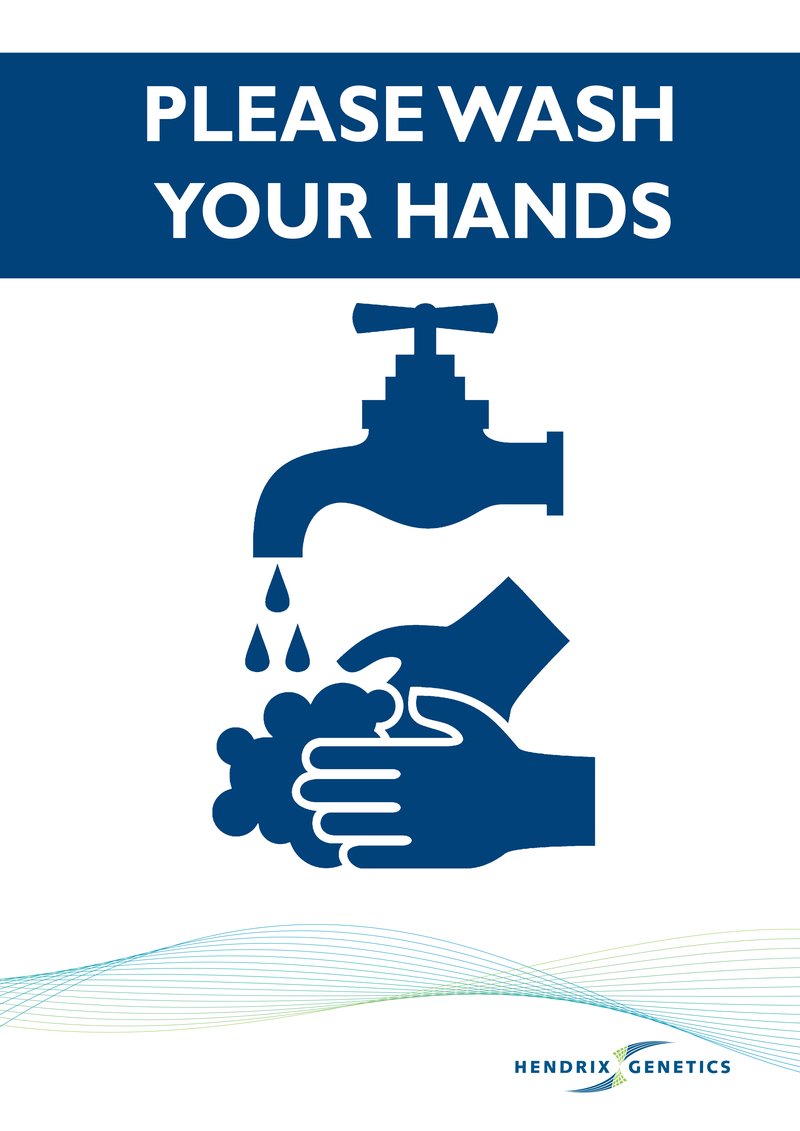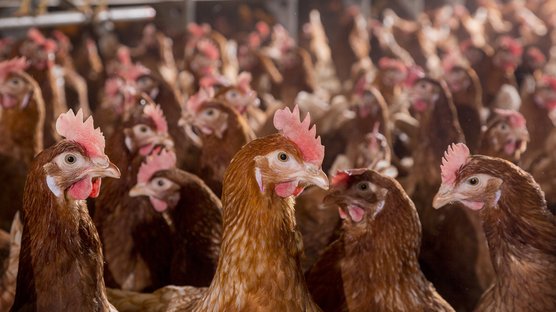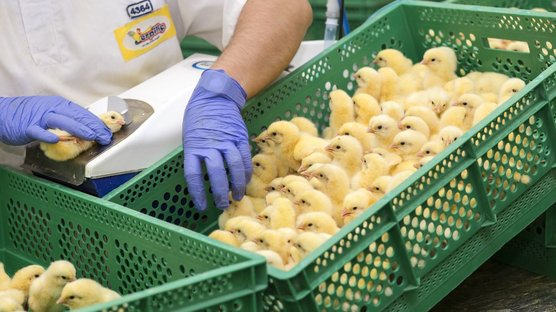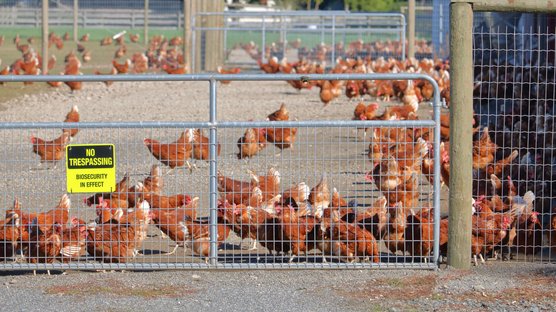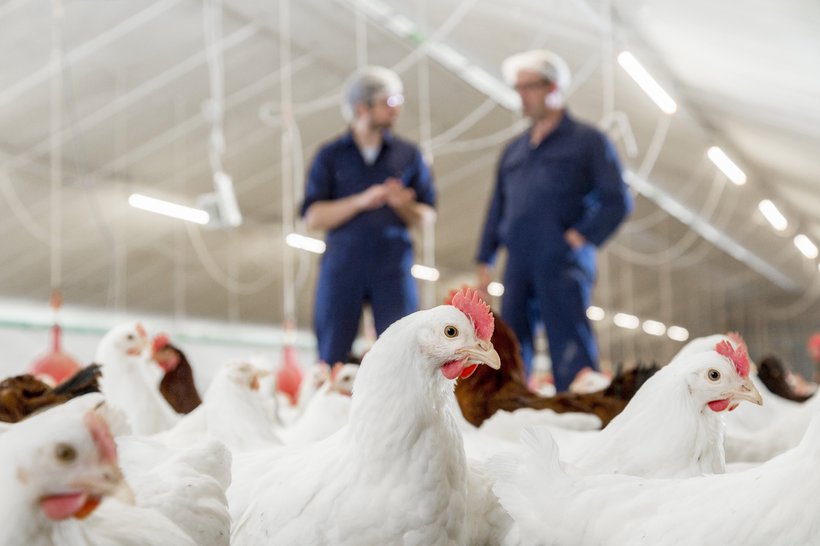
Published on Dec. 20, 2022
How to improve your biosecurity? 25 ways to bring your biosecurity to the next level
How can you increase biosecurity and reduce the risk of Avian Influenza / bird flu? By being consistent in hygiene and biosecurity, you can reduce the chances of the introduction of the virus through humans, animals, vehicles, or materials. Other concerns: preventing wild birds or pests from coming near the barn and preventing the virus from entering through the air. We have listed 25 effective measures that have proven to help in reducing the chance to become infected with the HPAI virus.
- Provide clearly identifiable hygiene zones, and visible physical separations between the various areas in the barnyard: the dirty area, the transition area, and the clean area (where the birds are).
- Keep the farmyard clean. Make your farmyard as unattractive as possible to wild birds and pests. For example, pallets are ideal hiding spots for wild birds, mice, and rats. If you are constructing a new barn, the storage of building materials is of course unavoidable, but do clean up everything as soon as the construction is finished.
- Make the direct surroundings of the poultry farms bird unfriendly. Keep grass near the barns short and remove unnecessary vegetation, as they can be perfect hiding and nesting places for wild birds and pests. Provide paving around the barns, but make sure that rainwater can easily drain away.
- Clean up feed scraps, not just at the feed silos, but everywhere on the poultry farm premises. If you use feed bags, dispose the bags immediately, don’t leave them around.
- Screen storage of materials and bedding as much as possible so that it cannot encounter wildlife as their infected droppings can stay around for weeks/months. Inspect the materials carefully when removing them from storage and before inserting them in the poultry houses.
- Make sure your yard has good drainage; this prevents the occurrence of rain puddles in the farmyard and in the range. These rain puddles are attractive to wild birds and pests. Make sure you do not walk in the rain puddles, as you could easily bring along the virus via your boots.
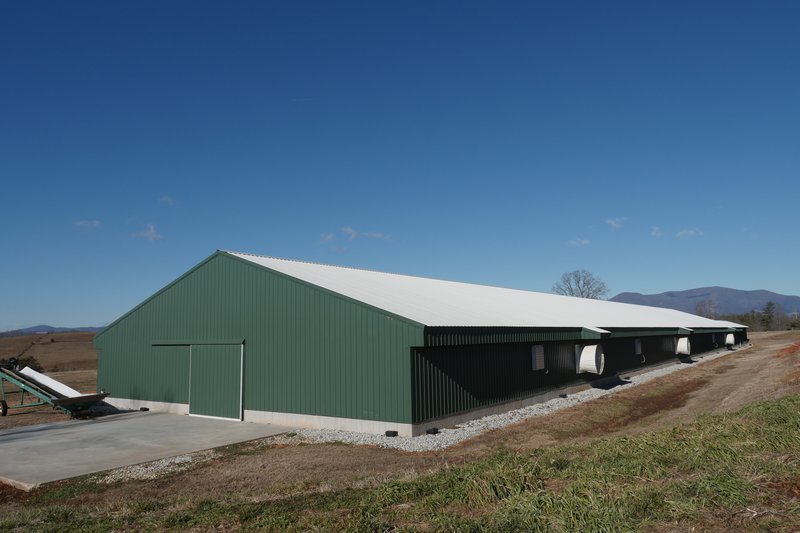
The area around the poultry house should be clean, the gravel around the barn allows for good drainage of rain water. effective rodent control, outside of the house is in place.
- Contaminated bird droppings can be deposited by wild birds on the roofs of the poultry houses. When it rains, these contaminated droppings will flow down, and can easily get near the inlet valves, or can enter the barn via splash water. Installing gutters, downspouts and proper drainage/drainage significantly reduces the chance of contamination. Tip: Clean the gutters at least annually.
- Excavation and dredging activities in the area also pose a risk. Dredging mud attracts birds as well as pests. Try to make arrangements with the developer about when the work takes place, so preferably when the farm is vacant and when the wind is not full on the barn.
- Mowing and harvesting activities release a lot of dust; this dust may contain poop from infected birds. In addition, harvesting attracts many wild birds, such as geese, pigeons and wild ducks. Are you mowing or harvesting nearby? If so, cover the barn air intakes with netting (windbreak netting).
- Do you come across dead wild bird, or dead wild mammals near your farm? If so, make an immediate report to the state or local authorities that are dealing with animal diseases. This will allow the carcass to be removed quickly.
- Seal all the cracks and holes of the barns, as this will keep pests out. Control pests not only in the barns, but also in the barnyard. Do this throughout the year. Professional pest and pest control professionals can be of great help, as they are often more effective.
- Laser beams are effective for scaring away wild birds and waterfowl at night. You may not see these animals near your farm or in the range during the day, but mallards and geese have been known to use the walkout at night in search of food (do check with your local authorities to see if you need a permit to use a laser beam).
- Fine-woven windbreak netting for poultry house air intakes lowers the risk of airborne avian flu infection. It is very likely that windbreak netting also provides good protection when the bird flu virus is attached to larger particles, such as insects, feathers, and manure. The HPAI virus can remain active in manure for weeks or even months! Additional advantage: windbreak netting also provides a barrier against pests such as flying insects.
- The air intakes can also be shielded with hoods, windbreak- or insect netting. Don’t forget that the HPAI virus can be carried along via flies, beetles, and other flying insects.
- New pullet flocks may already be carrying along the HPAI virus. Therefore, when housing the new flock, keep a close eye on the health of the animals.
- Humans are a risk factor for the introduction of bird flu. Ingress can occur through poop under footwear and on clothing, or through materials containing manure particles. Therefore, it is recommended that a no-visit zone be established for your farm. Only visits that are necessary for animal health, animal welfare and public health are allowed. So your veterinarian is welcome in the barns, but your feed consultant is not. Make it clear that visitors are not welcome in your yard, make sure there is a good separation between farm grounds and the area around the poultry houses. Also make sure you keep good records of farm visitors.
- Keep the vehicles of yard workers off the property. If that is not possible, such as the feed truck, make sure the wheels and wheel wells are carefully disinfected.
- Place your cadaver (dead bird) barrels by the road, this allows the cadaver truck to stay on the public road, so it does not have to enter the company premises (they carry dead birds and visit many farms on a single day). Carefully clean and disinfect the cadaver barrels after they have been emptied. Provide extra cadaver barrels so that you have enough time to carefully clean and disinfect the barrels.
- Don’t forget that disinfection works well only after careful cleaning is done first. An entry disinfection container works only when it is cleaned frequently, and thus clean. The average soaking time of disinfectants is also often more than 10 minutes. More effective is the careful changing of footwear and clothing.
- It is highly recommended to install a walk-through shower, and please do oblige all your visitors to use the shower. Showering removes, inactivates, and kills germs. Ensure good shower hygiene. Tip: The more comfortable the shower, the better it will be used. Blowing the nose can also help remove contaminated dust particles.
- Provide sufficient and clean work clothing, which should be put on after showering. Use separate footwear for each barn/house, and preferably barn-specific clothing, to prevent the introduction of diseases from one barn to another.
- Provide adequate opportunities for washing and disinfecting hands.
- If you see slightly increased shedding or observe signs of illness that may indicate bird flu. Contact your veterinarian immediately. The quicker the diagnosis can be made, the more effective the approach. By doing so, you reduce the chance that the virus can spread to other farms.
- Do not allow pets inside the poultry houses, and preferably also not on the premises, they can be carriers of various germs and viruses.
- Never mix animals of different ages and origins in the same barn. Ensure proper routing on the farm yourself based on the age as well as the health status of the different flocks/stalls.
These are just a few basic tips and tricks that will help to reduce the chance of infection of Highly Pathogenic Avian Influenza. Your local animal health authorities should be able to guide and support you in improving the biosecurity on your poultry operations further. The information in this article has been obtained by recent publications from AVINED and PLUIMVEEHOUDERIJ, and further improved with the input of our poultry veterinarians.
